As the days go by, I’m finding more and more berries ripening in the garden. Our birds , insects and animals come to rely on what is growing in our gardens. Those that will be hibernating have to stock up on food, eating as much as they can so that they will survive through the winter. I’m thinking of our little Dormouse that will sleep until April!
Birds come to eat the berries on offer, sometimes these are birds from way up in the north that have come south or west to milder conditions in Britain. Usually strong easterly winds bring Fieldfares and Redwings from the Continent and bushes can be stripped in just a couple of days.
The books all state that birds eat the red berries first, then orange, yellow and white. My Pyracantha bush by the front entrance with orange berries, is always stripped first before the one with red berries by the field.
Cotoneaster horizontalis by the kitchen, is growing up the wall and now isn’t horizontalis any more, more verticalis! The blackbirds love these berries.
One year we noticed that the Berberis by the front door, which was covered in red berries, was stripped by Fieldfares in just 2 days.
This honeysuckle is in the woodland and I like to think that the Dormouse might get a chance of eating these berries as long as the birds leave them alone.
These lovely long tassels tempt the blackbirds to jump up to get the berries, in the spring there are tiny white flowers where there are now berries.
Who eats all the fuchsia berries? I’ve never seen anything eating them, but they vanish. They are supposed to be edible for us humans, but I have never been tempted to make a pie out of them!
The bush of Rosa glauca is laden with rose hips at the moment, I like to think that they provide much needed nourishment for the wildlife in the garden.
Arum italicum marmoratum pops up all over the garden, thanks , I presume to the birds eating the berries and depositing the seed under the bushes where they sit.
We have plenty of blackberries in our boundary hedges, sometimes we pick a few for ourselves. Blackberry and apple crumble is so lovely and the cooking apples are just ready now too. We do leave plenty for the wildlife however, they don’t go short!
Sambucus Black Lace, beyond the pond, is covered with lovely black berries at the moment. The little mammals as well as the birds will enjoy these berries. We have quite a lot of voles in the garden and I’m sure they will scramble up and over the trees and shrubs to get at the berries. Having the voles in the garden means that we always have a Tawny Owl not far away!
We have quite a few Hawthorn trees or shrubs in the garden, thanks to the birds dropping the seed everywhere! It depends where they are, whether they are allowed to stay or not, but we always leave a few for the berries.
Damsons in the fruit and veggie garden have been picked and frozen. At least the nice, fat, juicy, plump ones have been, the small ones have been left for the wildlife to enjoy.
Lonicera pileata forms a short hedge under the kitchen window. The metallic purple berries are formed inside the hedge and you really have to go looking for them. The blackbirds have got the knack of finding them, but we haven’t seen other birds enjoying them.
Beech nuts form on my small tree in the front garden. It is a cross between the English oak and the American Copper Beech. The gravel underneath gets covered with the beech mast or nuts, possibly squirrels eat them or other small mammals, but whoever it is, they don’t last long.
I have never planted an Hypericum here, all the ones that pop up are courtesy of the birds dropping the seed. We keep pulling them out, but we always seem to have the same number!
There is a big bush of Taxus baccata in the back garden which is covered in berries at the moment. We are always finding yew seedlings all round the garden and I keep saying that I must dig them up and make a hedge out of them!
Not berries, I know, but my Acer is producing so many seeds at the moment, I think my dormouse and other small mammals might find that they make a tasty tit-bit.
We end up with Holly berries. Once again we have plenty of holly bushes in the hedges courtesy of the birds, some get pulled out while they are tiny, others are allowed to develop.
I hope you will agree that the larder has plenty to appeal to the birds and animals that choose to live in the garden, along side us. We have always tried to live in harmony with the wildlife around us and I feel the seal of approval was given when a dormouse chose to take up residence about 5 yrs ago. I don’t think it can be the same one with us now, but we feel honoured that its descendants have decided to stay with us.

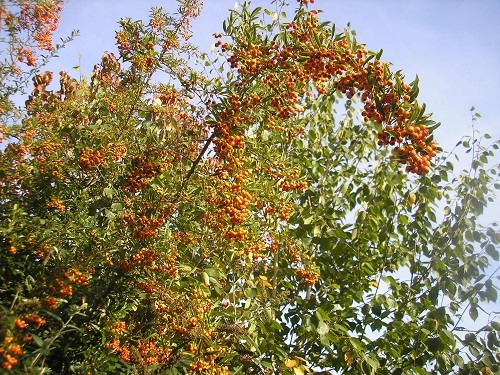



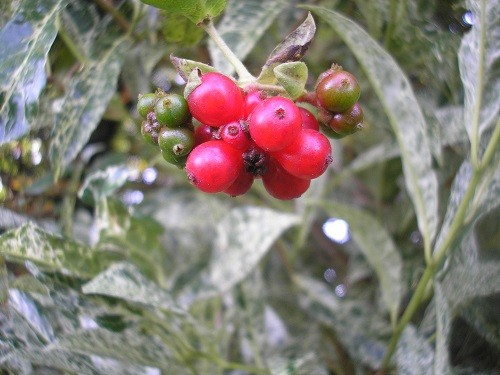

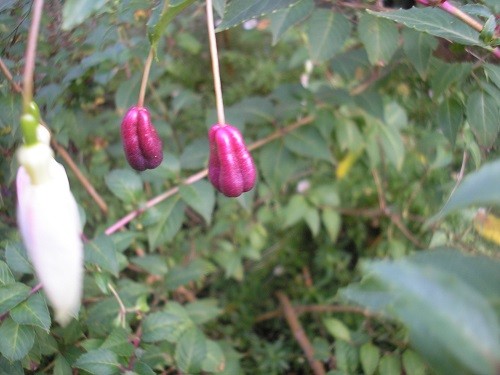
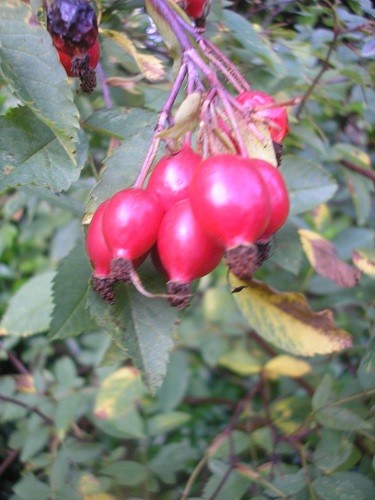
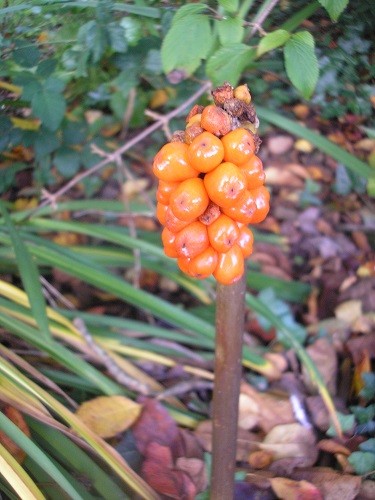








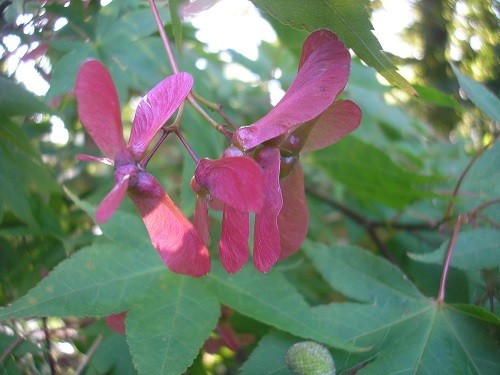

Is now the time to sow the Acer seeds? My Osakazuki has some too.
Leycesteria formosa has the common name of pheasant berry. Supposed to be quite attractive to you know who.. just sayin’ 🙂
Jennifer, I think we have to wait just a little longer. I always collect other seeds when they go brown, so I think it would be best to do the same for the Acer. I do have 2 little trees growing in the greenhouse, they must be about 9 inches tall by now, so maybe they can face the elements in the garden this winter.
I hope I’m not speaking too soon, but Mr P doesn’t visit my garden at this time of year, only when it is cowslip and fritillary time! I’ve only ever seen the blackbird jumping up for the Leycesteria berries.
Lovely post with all the different berries that you have. We only have a small selection of those; in fact the only ones I have seen being eaten are the Pyracantha and the Cotoneaster. It seems to be the Blackbirds that go for both of them.
I think blackbirds do the best Annette, out of all the birds, we seem to have plenty of berries that they enjoy!
I bet the local wildlife sends out the message far and wide that there is a feast in your garden! And so much beauty too, at least until your dormouse and friends have their way…
You could be right Janet, birds seem to come from far and wide when there’s berries on offer! We have a couple of mature Ivy bushes where the berries don’t mature till Dec/Jan, so there are still berries late on for them to enjoy and the dormouse is hibernating by then!
Really lovely post Pauline, I love the descriptions of your wildlife enjoying the berries and fruits you have growing. It must of been so exciting to discover a dormouse. I’d love to have Feildfares visit my garden we occasionally get one or two, en route to the local hedgerows, but I haven’t enough to keep them around for long.
Thanks Julie, it certainly was a wonderful day when we discovered our little dormouse. We usually get a few Fieldfares and Redwings when the temperature drops and the wind is coming from the east in the winter. They don’t stay very long, just until they have stripped the bushes bare!
I hope your little dormouse is not a lonely solitary soul. Such tiny creatures.
I don’t think Diana, that it can be just one, to still have them after seeing the first one 5 yrs ago, something must be going on as they don’t live very long.
What a marvelous post, how I enjoyed it! You are certainly providing for wildlife, they need all the help they can get over winter.
My orange Pyracantha goes before the red one too. I can always tell what the birds are eating by the poops, at the moment they all seem to be black, blackberries and alder!
How lovely that you have dormice and voles, great to see a garden that is doing so much for people and wildlife. Now, my woodpigeons gorge themselves on beech nuts, they simply can’t get enough of them.xxx
So that’s who is eating my beech nuts Dina, I wondered who it was! We always seem to have plenty of woodpigeons in the garden who wait for the bits that drop from the bird feeders. Their numbers are kept under control by regular visits from a Sparrowhawk, I usually find the gruesome remains in the woodland!
Eeek! Poor you! I have seen the process….awful it is, but that’s nature for you. We didn’t create the system!xxx
I left the last one we found in the woodland to see if it was taken in the night, it was, no sign of it next day, probably a fox took it.
I love that your garden is filled with good things to eat for the birds and other wild creatures. The birds seem particularly active in my garden now. I suppose they are getting ready for winter like all the rest of the animals. I love to watch them strip a shrub of berries, though I have not noticed that they prefer berries in any particular color order. I have noticed that they like berries to be ripe.
Deb I think all the wildlife is getting ready for the winter season, either feeding madly before hibernating or feeding to put on a layer of fat to keep them going until warmer weather arrives. I like having so many berries in the garden, then I can sit with my coffee and watch the birds as they feed, I think the mammals feed mainly at night, so there is great excitement when we spot something moving in the undergrowth.
The garden looks like it is absolutely overflowing with berries and nuts for all of the animals to stock up on! I love the bright colours that these berries bring to the autumn landscape.
I agree Matt, the berries bring more colour to the garden at this time of year, adding to the changing colour of the leaves. We do have quite a lot of shrubs with berries and we know that they are enjoyed because all the fruit vanishes!
What a wonderful mix of berries and fruits for the wildlife! I have watched flocks of tiny birds devouring beech nuts – I suppose they were some kind of warbler. They all sat on the branches of the trees and fluttered and flapped so that the whole tree vibrated, then they flew to the ground and ate the beech nuts that had fallen!
Love your story of the little birds vibrating the tree to shake the beech nuts to the floor Cathy, we’re not the only ones with brains, how ingenious of them!
Still not getting your posts, Pauline so have tried resubscribing AGAIN… Must have missed lots of them in recent months 🙁 What a wonderful assortment of berries and hips you have to feed the local wildlife – I saw some HUGE rose hips in a hedge we passed today so will be googling to find out what sort of rose they might be from…
Cathy, I don’t know what to suggest, I’m so sorry that you’re not receiving e.mails. I’ll have to have another word with my son, but others seem to have been sorted by resubscribing, apparently it was a WordPress problem at the time.
The birds and animals have a good variety of berries to choose from, hopefully there is plenty for everyone.
Your rose hips probably belong to Rosa rugosa if the hips are like red tomatoes, there are different varieties, depending on what colour the flowers were.
You’ve created a wonderful environment for wildlife (and for yourself). Interesting to see what variety your garden hosts.
It is good that we can all live side by side Susie, with the garden flourishing and keeping us all happy. One day I must make a list of all the wildlife that we share the garden with, I think it might be quite a long list!
What a brilliant and most enjoyable post, it’s so interesting to know which creature is eating which berry and when. I’ve not noticed the sequence of which berries go first, how intriguing, or equated the number of voles with barn owls. We get a lot (of both) I love listening to the young ones learning how to hoot.
Thank you Kate. We saw a barn owl the other evening, not far from where we live but mainly we have tawny owls in the garden, I think they like the little bit of woodland that we have. We see plenty of mice, voles and shrews, the voles make a quick dash to the bird table for any dropped seed, but the mice and shrews seem to keep to the back of borders where there is plenty of cover.
What a wonderful, and colorful and generous feast for the birds and small creatures in your garden.
I have always tried to garden with wildlife in mind Woodland Gnome, I feel it is good that we can live side by side, after all, the wildlife was here when the garden was part of the farmer’s field!
How wonderful that you have so many bushes that provide feed for birds and many other animals. That is my one big problem with this new foraging fad, that people who don’t really need it, because, if we’re honest, it’s not mainly people who have trouble paying for their groceries who go foraging, go out and strip bushes and forest floors of berries and fungi with not much thought, it seems, for the wildlife that is dependent on this food. So great to see that in your garden there seems to be a very abundant larder.
I suppose Helle, that I feel the wildlife was here before the house was built, the land was part of the field next door. If I can grow shrubs that are nice for me as a gardener as well as being good for wildlife, if they have autumn tints as well, then it is a win win situation. I hope that I have plenty of food for them all, I don’t think I can fit in any more shrubs!